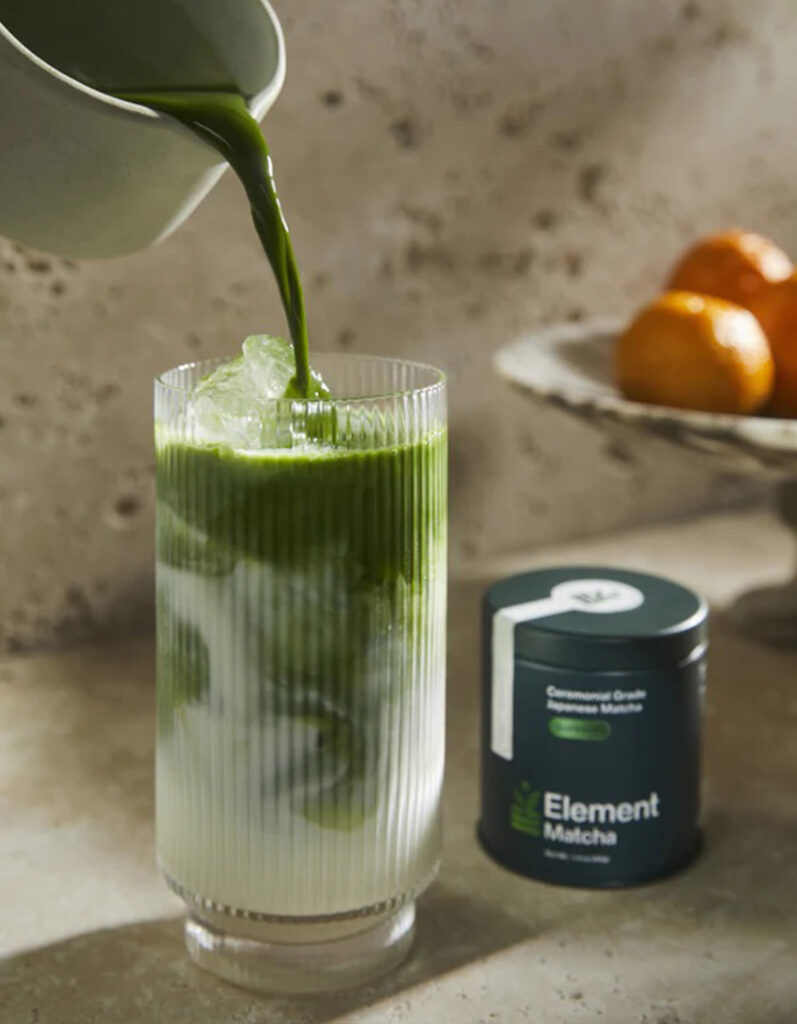I. Executive Summary for Ecommerce Brand
Element Matcha is an ecommerce brand focused on providing premium, organic ceremonial-grade matcha and related accessories. In a growing yet competitive market, Element Matcha aims to differentiate itself through product quality, brand storytelling, and a strong online presence. This case study outlines a hypothetical digital marketing strategy designed to increase brand awareness, drive traffic to the Shopify store, boost conversions, and foster customer loyalty.
II. Background
The global matcha tea market is experiencing significant growth, driven by increasing consumer awareness of health benefits and a rising interest in healthy lifestyles. Key drivers include matcha’s antioxidant properties, stress-relieving capabilities, and versatility in various applications (beverages, culinary, cosmetics). The market is competitive, with a mix of established brands and new entrants. Success hinges on effective branding, storytelling, and digital marketing to capture consumer attention and build a loyal customer base.
Element Matcha’s product offerings include:
-
Organic Ceremonial Matcha
-
Superior Ceremonial Matcha
-
1LB Organic Premium Restaurant Grade Matcha
-
Matchaware (Haku-Yu Matcha Bowl, Bamboo Matcha Whisk, Dual-Speed Electric Matcha Whisk, Matcha Serving Spoon)
-
Ceremonial Matcha Starter Kit
-
Wholesale Matcha
III. Digital Marketing Objectives
-
Increase Brand Awareness: Establish Element Matcha as a leading provider of high-quality, authentic matcha.
-
Drive Qualified Website Traffic: Attract visitors who are actively searching for matcha products or are interested in health and wellness.
-
Boost E-commerce Conversions: Convert website visitors into paying customers.
-
Enhance Customer Loyalty & Retention: Encourage repeat purchases and build a strong community around the brand.
-
Expand Market Reach: Potentially tap into new demographics or geographic regions.
IV. Digital Marketing Strategies & Tactics
A. Search Engine Optimization (SEO)
-
Keyword Research: Identify high-intent keywords such as “organic ceremonial matcha,” “best matcha tea,” “matcha starter kit,” “Japanese matcha,” and long-tail keywords related to matcha health benefits, recipes, and preparation.
-
On-Page SEO: Optimize product pages, collection pages, and blog content with relevant keywords in titles, meta descriptions, headings, and body text.
-
Content Marketing: Develop a comprehensive blog strategy featuring articles on:
-
“The Health Benefits of Ceremonial Matcha”
-
“How to Prepare the Perfect Bowl of Matcha”
-
“Matcha Recipes for a Healthy Lifestyle”
-
“The Origin and Tradition of Japanese Matcha”
-
“Matcha vs. Coffee: Which is Right for You?”
-
This not only helps with SEO but also educates consumers and establishes Element Matcha as an authority.
-
-
Technical SEO: Ensure the Shopify site is mobile-friendly, loads quickly, and has a clear site structure for easy crawling by search engines. Implement structured data (schema markup) for products and reviews.
-
Link Building: Acquire high-quality backlinks from health and wellness blogs, food publications, and reputable e-commerce directories.
B. Social Media Marketing
-
Platform Focus: Primarily Instagram, Pinterest, and TikTok for visual storytelling, with Facebook for community building and targeted advertising.
-
Content Pillars:
-
Educational: Matcha preparation tutorials, health benefits, cultural insights.
-
Inspirational: Aesthetic photos and videos of matcha moments, lifestyle integration.
-
User-Generated Content (UGC): Encourage customers to share their Element Matcha experiences using branded hashtags (#ElementMatcha, #InYourElement). Repost compelling UGC to build community and social proof.
-
Product-focused: Showcase product features, new arrivals, and special offers.
-
-
Influencer Marketing: Collaborate with micro-influencers and wellness bloggers who align with the brand’s values to reach targeted audiences authentically.
-
Paid Social Advertising:
-
Targeting: Utilize detailed audience targeting based on interests (e.g., healthy eating, yoga, meditation, tea, Japanese culture), demographics, and lookalike audiences.
-
Ad Formats: Employ engaging video ads, carousel ads showcasing product ranges, and Instagram Shopping ads.
-
Retargeting: Re-engage website visitors who viewed products but didn’t purchase.
-
C. Email Marketing
-
List Building: Implement pop-ups, exit-intent offers, and lead magnets (e.g., “Matcha Recipe Guide” download) on the website to capture email addresses.
-
Welcome Series: Automate a series of emails for new subscribers introducing the brand, its mission, and product benefits, often including a first-purchase discount.
-
Abandoned Cart Recovery: Send automated emails to users who leave items in their cart, reminding them of their selection and offering incentives to complete the purchase.
-
Promotional Campaigns: Regularly send newsletters about new products, seasonal offers, and exclusive discounts.
-
Customer Segmentation: Segment email lists based on purchase history, engagement levels, and product interests to deliver personalized content and offers.
-
Educational Content: Share blog posts and matcha tips via email to foster engagement and position the brand as an expert.
D. Paid Advertising (PPC)
-
Google Search Ads: Bid on high-intent keywords (e.g., “buy ceremonial matcha online,” “organic matcha powder,” “matcha accessories”) to capture users actively searching for products.
-
Google Shopping Ads: Showcase Element Matcha products directly in Google search results with images, prices, and direct links, a critical channel for e-commerce.
-
Display Advertising: Utilize Google Display Network for brand awareness campaigns, targeting relevant websites and audiences.
-
Remarketing: Display ads to users who have previously visited the Element Matcha website.
V. Website Optimization (Shopify-Specific)
-
User Experience (UX): Ensure intuitive navigation, clear product categorization, high-quality product images, and detailed product descriptions.
-
Mobile Responsiveness: Optimize the website for seamless Browse and purchasing on all devices.
-
Conversion Rate Optimization (CRO):
-
Clear Calls to Action (CTAs): Prominently display “Add to Cart” and “Buy Now” buttons.
-
Customer Reviews: Integrate product reviews and testimonials to build trust and social proof.
-
Secure Checkout: Reassure customers about the security of their transactions.
-
Bundles & Subscriptions: Offer product bundles (e.g., starter kits) and subscription options for recurring purchases to increase Average Order Value (AOV) and customer lifetime value (LTV).
-
-
Shopify Apps: Leverage apps for email marketing (e.g., Klaviyo), reviews (e.g., Loox, Judge.me), loyalty programs, and upsell/cross-sell functionalities.
VI. Key Performance Indicators (KPIs)
-
Website Traffic: Unique visitors, page views, bounce rate.
-
Conversion Rate: Percentage of visitors who make a purchase.
-
Average Order Value (AOV): Average value of each purchase.
-
Customer Acquisition Cost (CAC): Cost to acquire a new customer.
-
Customer Lifetime Value (LTV): Total revenue expected from a customer over their relationship with the brand.
-
Return on Ad Spend (ROAS): Revenue generated for every dollar spent on advertising.
-
Social Media Engagement: Likes, comments, shares, follower growth.
-
Email Marketing Metrics: Open rates, click-through rates, conversion rates from emails.
-
Organic Search Rankings: Position of keywords in search engine results.
VII. Potential Challenges & Mitigation
-
Market Saturation: Differentiate through unique branding, emphasis on organic and ceremonial grade quality, and strong storytelling.
-
High Customer Acquisition Cost: Optimize PPC campaigns for efficiency, focus on organic growth through content and SEO, and leverage loyalty programs.
-
Customer Retention: Implement robust email marketing sequences, loyalty programs, and personalized communication to encourage repeat purchases.
-
Educating Consumers: Many consumers may not be familiar with high-quality matcha. The content marketing strategy will be crucial here to educate and inform.
VIII. Conclusion
By implementing a multi-faceted digital marketing strategy encompassing SEO, social media, email marketing, and paid advertising, Element Matcha can effectively reach its target audience, drive sales, and build a strong, loyal brand community in the competitive matcha market. Continuous monitoring of KPIs and agile optimization of campaigns will be essential for sustained growth and success.
Success of Element Matcha hinges on effective branding, storytelling, and digital marketing to capture consumer attention and build a loyal customer base.


